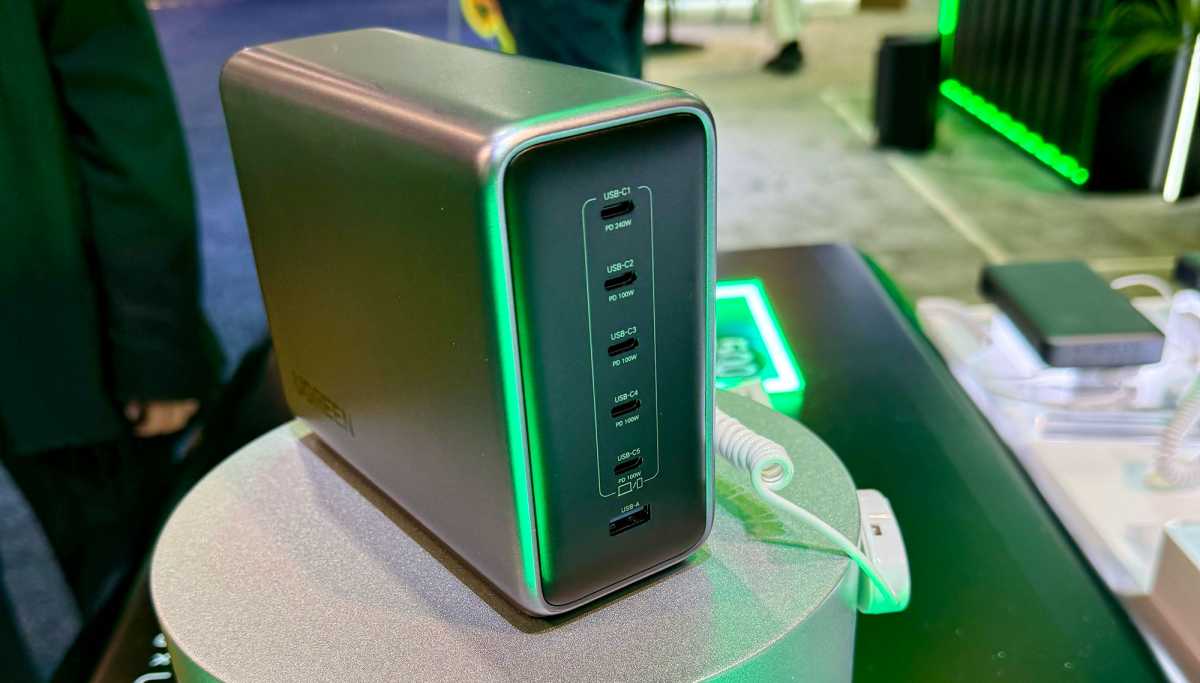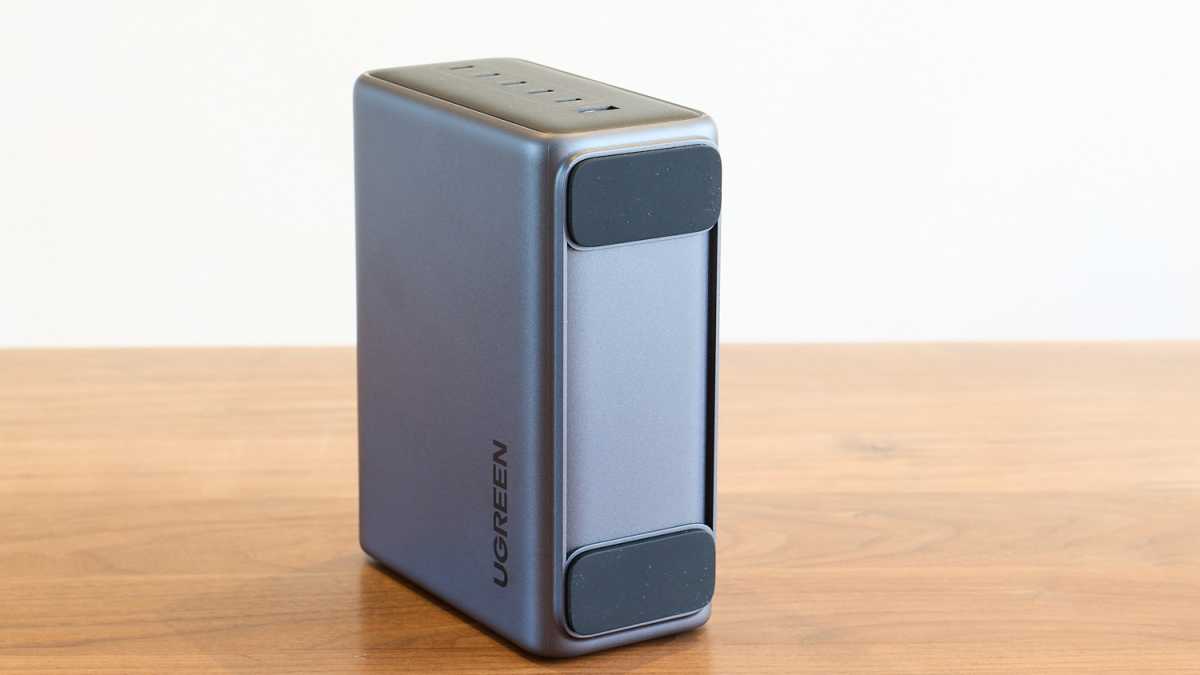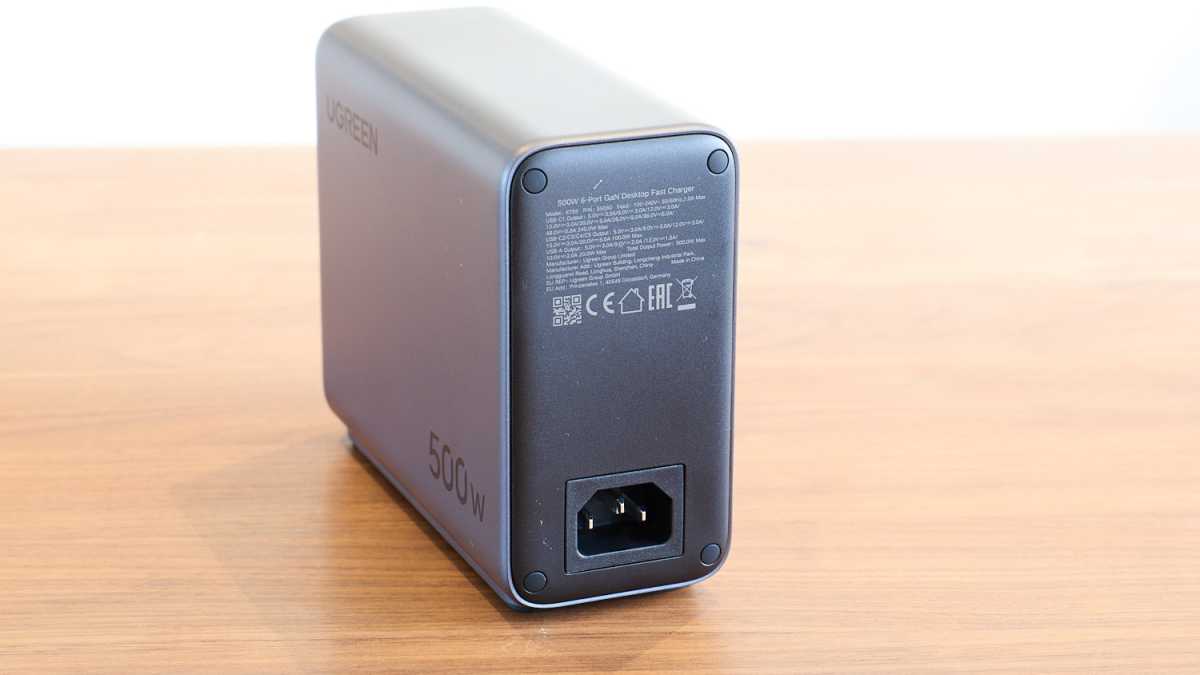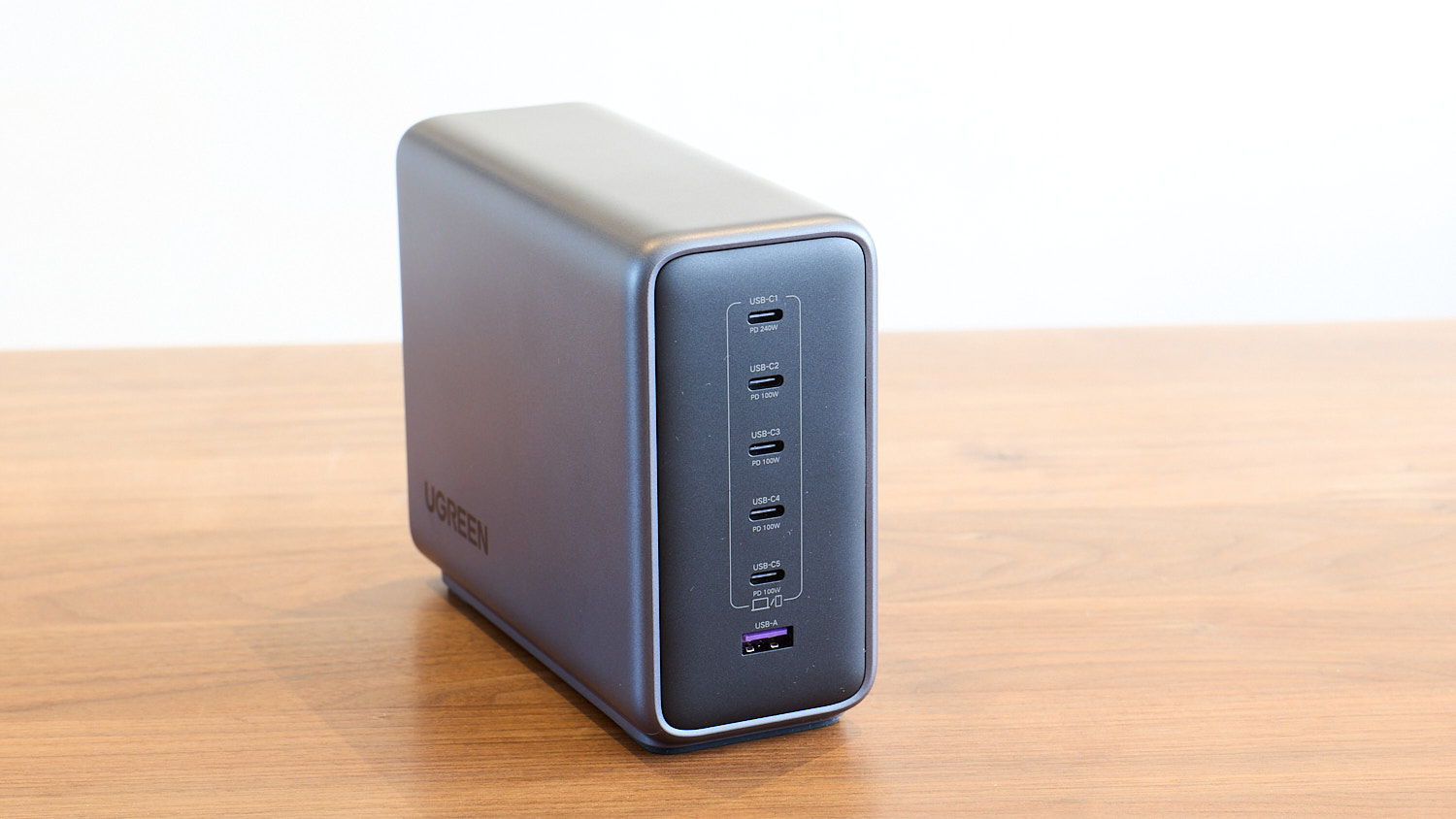 At a glance
At a glance
Expert’s Rating
Pros
- Massive 500W total output
- 6 ports
- 140W PD 3.1 charging
Cons
- Top port hogs 240W
- USB-C cable not included
Our Verdict
You won’t find a desktop charger with this high a maximum power output, and few others boast as many ports.
Price When Reviewed
This value will show the geolocated pricing text for product undefined
Best Pricing Today
Price When Reviewed
$249.99
Best Prices Today: Ugreen Nexode 500W Desktop Charger
Chargers range in size from minuscule wall-based plugs to bulkier desktop bricks, in number of ports from one to ten, and in total output power from 20W (not enough) to now 500W (now you’re talking!).
The 6-port Ugreen Nexode 500W Desktop Charger beats our previous tested champ, the Nexode 300W also from Ugreen.
The new 500W model can power five MacBooks at the same time and still have some power remaining for your phone or AirPods.
Desktop power
There are some impressive USB-C wall chargers that plug directly into the power socket. The Anker 140W Charger has four ports, including two 140W ports rated at PD 3.1 each of which is powerful enough to fast charge a 16-inch MacBook Pro, although not at the same time as maximum power output is capped at 140W (and indeed 134W when charging four devices).
Ugreen has a 4-port 160W wall charger with one 140W PD 3.1 port.
If you need much more power, you should be looking for a desktop charger that connects to the power socket via an old-fashioned plug and cable. Desktop chargers has more ports and can output more power than wall chargers. They are ideal if you have a lot of devices requiring high power as they reduce the need for multiple individual chargers.

Simon Jary / Foundry
Ports of power
- 1x USB-C (240W PD 3.1)
- 4x USB-C (100W PD 3.0)
- 1x USB-A (22.5W)
The Nexode 500W boasts six front-facing charging ports: five USB-C and one legacy USB-A.
The first USB-C port (C1) can output at a massive 240W, which is far more than any USB-C-powered devices require. Maxed-out power-hungry gaming laptops gain their power with a direct AC input rather than USB. We expect more electric bikes to charge via USB-C and 240W of power might be the sweet spot for those devices, but it’s rare in desk-based consumer electronics.
The most you are likely to use it for is the 140W needed to fast charge the 16-inch MacBook Pro using either Apple’s MagSafe 3 cable or a 240W USB-C charge cable for post November 2023 models.
(Note that the Nexode 500W doesn’t ship with a USB-C cable, so check that the cables you do have are rated as you will need them. Most USB-C charging cables max out at 60W. See our roundup of the best USB-C cables for recommendations.)
The high-output C1 port is also fine to charge lower-powered devices, but its real strength is aimed at laptops that require a PD 3.1 (up to 240W) power source.
The other four USB-C ports (C2, C3, and C4) are rated at 100W charging potential. The USB-A port can each output 20W.
Maximum power output is 500W but you can’t just plug in five laptops and expect each to receive 100W at the same time. Chargers tend to have some limitations when powering multiple devices simultaneously.
Ugreen lists 58 charging configurations in the user manual. If you use just three of the ports each will give you its maximum, but once you add a fourth, fifth or sixth, the remaining ports are compromised somewhat with the otherwise 100W ports dropping to 60W.
500W is certainly possible. For example, 240W+100W+100W+60W. But Ugreen doesn’t state that you can get 140W+100W+100W+100W+60W. The C1 port reserves that whole 240W for itself and won’t share it if it’s not using it all. Effectively this makes the 500W max power output more like 400W due to 100W of the 240W realistically not being used or released to the other ports. Keeping the C1 to 140W and sharing the extra 100W would have offered more charging flexibility.
In our tests, the Nexode 500W charged an iPhone 15 by 54%, an 11-inch iPad Pro by 36%, and a MacBook Air M3 by 50% in 30 minutes (this testing by Macwelt’s Thomas Bergbold).
Four MacBooks can draw power at 60W each, with another at 140W. Even three 16-inch MacBooks running simultaneously can be charged: one fast-charged at 140W and the other two at 100W.

Thomas Bergbold
Who is it for
Having so much power to output to so many devices means the Nexode 500W Desktop Charger will be most useful in a conference room or in a classroom with five laptops needing just one charger; say at 240W+60W+60W+60W+60W.
60W is enough to keep most laptops charged up and in use unless they are really pushing it on hungry video-editing applications.
The benefit of one super-powered desktop charger is that you no longer need so many power points or individual wall chargers. It will reduce desk clutter and end a world of snaking cables slithering off the table to find a power outlet.
Design
The Nexode 500W measures 5.75 x 4.5 x 2.4 inches (14.6 x 11.5 x 6.1cm) and weighs a mighty 4.8lbs (2.2kg).
That compares to the former power champ, the Ugreen Nexode 300W Desktop Charger, that has dimensions of 4.6 x 3.75 x 2.1 inches (11.6 x 9.5 x 5.3cm), and weighs about half as much.
It’s certainly solid and you could hold a heavy gate open using it as a doorstop, but it’s good-looking in a slightly menacing way in dark gun-metal aluminum. The nicely rounded edges maybe soften the brutal looks.
You might expect a 500W charger to get hot. We certainly know much lesser chargers can heat up quite quickly. But the Nexode 500W stayed quite cool even when we tested it with multiple devices charging.

Thomas Bergbold
It doesn’t have any flashy lights or informative digital display so if you want to know how much power is going where and when, you won’t learn much looking at its front although each of the five USB-C ports has its maximum power rating printed below it.
If you want a desktop charger with a digital display showing charging status and speed we’d recommend the Anker Prime Charger that also boasts six ports but has a max power output of 250W.

Thomas Bergbold
Price and competition
The Ugreen Nexode 500W Desktop Charger is priced at $249.99 in the U.S., £219.99 in the U.K., and €249,99 in the E.U. There are cheaper desktop chargers but none with so much power on tap at the same time.
The closest competition to the Nexode 500W is the five-port Nexode 300W ($199.99 / £149.99) in terms of number of ports and massive power output. The 500W model has the extra 200W oomph plus a sixth port. The 300W model also boasts a 140W port but only two at 100W, with the fourth USB-C port limited to 45W, although its USB-A port is a tiny bit more powerful at 22.5W.
The $149.99 Satechi 200W USB-C 6-port PD GaN Charger is another option (direct / Amazon). While it boasts two 140W USB-C ports that 200W maximum makes this advantage meaningless.
If you want truly intelligent power distribution, the best we’ve seen is the ten-port Plugable PS-10CC desktop charger that uses software-based real-time current sensing technology to deliver priority charging that distributes power across all connected devices, prioritized in the order you choose from left to right. As devices reach full charge, the now greater available power is reallocated down the line. While a lot more clever than the Nexode 500W, it’s limited to just 100W of total simultaneous output.
Should you buy the Ugreen Nexode 500W Desktop Charger?
You won’t find a desktop charger with this high a maximum power output, and few others boast as many ports. While not all the ports work at their fullest when used simultaneously due to the top port hogging 240W to itself, this well-constructed tidy power block is built for team use and is easily capable of powering five laptops and an iPad at the same time in a neat and cool package.

